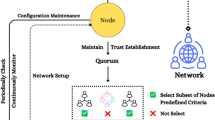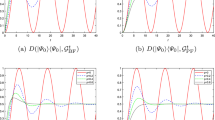Abstract
Fault-tolerance is increasingly significant for large-scale storage systems in which Byzantine failure of storage nodes may happen. Traditional Byzantine Quorum systems that tolerate Byzantine failures by using replication have two main limitations: low space-efficiency and static quorum variables. We propose an Erasure-code Byzantine Fault-tolerance Quorum that can provide high reliability with far lower storage overhead than replication by adopting erasure code as redundancy scheme. Through read/write operations of clients and diagnose operation of supervisor, our Quorum system can detect Byzantine nodes, and dynamically adjust system size and fault threshold. Simulation results show that our method improves performance for the Quorum with relatively small quorums.
Similar content being viewed by others
References
Ieslie L, Robert S, Marshall P. The Byzantine Generals Problem [J].ACM transactions on Programming Languages and Systems, 1982,4(3): 382–401.
Dahlia M, Michael K R. Byzantine Quorum Systems [J].Distributed Computer, 1998,11(4):203–213.
Martin J, Alvisi L, Dahlin M. Small Byzantine Quorum Systems [C]//Proc of the 2002 international Conf. on Dependable Systems and Networks. Bethesda, USA: IEEE Press, 2002:373–383.
Bazzi R A. Synchronous Byzantine Quorum Systems [J].Distributed Computing, 2000,13(1):45–52.
Alvisi L, Malkhi D, Pierce E,et al. Dynamic Byzantine Quorum Systems [C]//Proc of the 2000 international Conf. on Dependable Systems and Networks. New York, USA: IEEE Press, 2000:283–292.
Marcos K A, Ramaprabhu J, Lihao X. Using Erasure Codes Efficiently for Storage in a Distributed System [C]//Proc of the 2005 international Conf on Dependable Systems and Networks. Pennsylvania, USA: IEEE Press, 2005:336–345.
Saito Y, Frolund S, Veitch A. FAB: Building Distributed Enterprise Disk Arrays from Commodity Components [J].ACM SIGPLAN Notices, 2004,39(11):48–58.
Hafner J L. HoVer Erasure Codes For Disk Arrays [C]//Proc. of the 2006 International Conf. on Dependable Systems and Networks. Pennsylvania, USA: IEEE Press, 2006:217–226.
Azagury A, Dreizin V, Factor M,et al. Towards an Object Store//Proc. of the 20th IEEE/11th NASA Goddard Conf. on Mass Storage Systems and Technologies. San Diego, USA: IEEE Press, 2003:157–164.
Mesnier M, Ganger G R, Riedel E. Object-Based Storage [J].IEEE Communications Magazine, 2003,41(8):84–90.
Author information
Authors and Affiliations
Corresponding author
Additional information
Foundation item: Supported by the National Natural Science Foundation of China (60373088)
Biography: LIU Gang (1975-), male, Ph. D. candidate, research direction: network storage.
Rights and permissions
About this article
Cite this article
Gang, L., Jingli, Z., Yufen, S. et al. A fault detection mechanism in Erasure-code Byzantine Fault-tolerance Quorum. Wuhan Univ. J. Nat. Sci. 11, 1453–1456 (2006). https://doi.org/10.1007/BF02831796
Received:
Issue Date:
DOI: https://doi.org/10.1007/BF02831796




